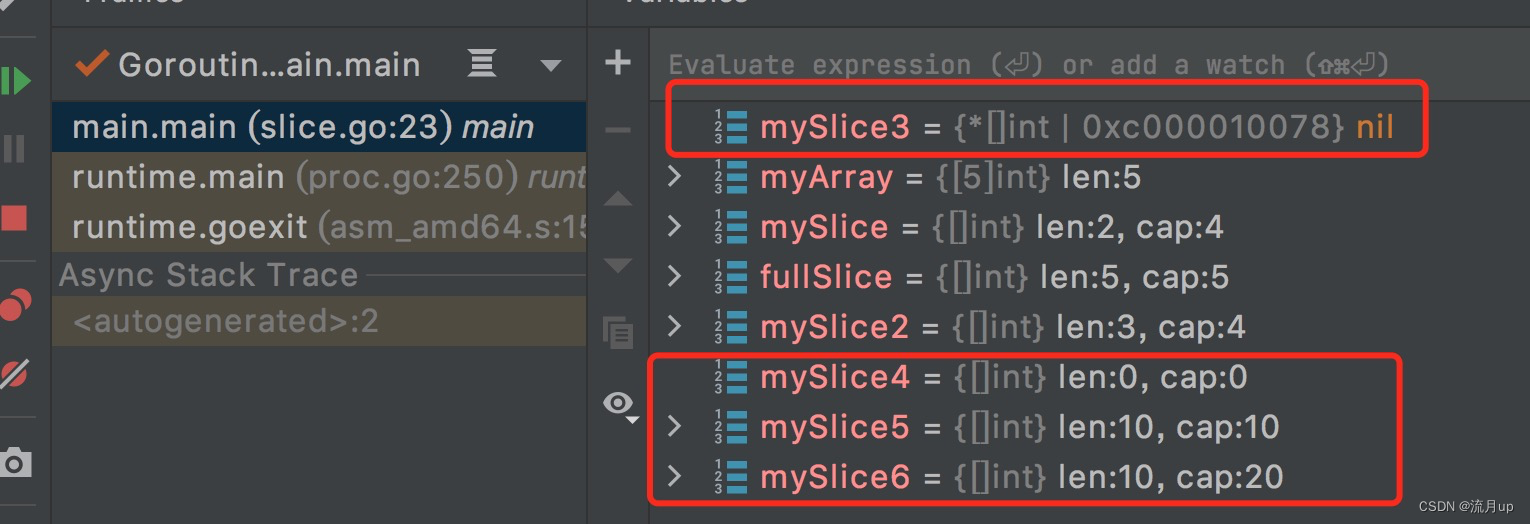3.goLand基础语法
发布时间:2024年01月16日
概述
从 java 转来学 go ,在此记录,方便以后翻阅。
语法
for
package main
import "fmt"
func main() {
for i := 0; i < 3; i++ {
fmt.Println(i)
}
fullString := "helloworld"
for i, i2 := range fullString {
fmt.Println(i, string(i2))
}
}

for-range
遍历数组,切片,字符串,Map 等
常量与变量
变量定义
- 变量
- var 语句用于声明一个变量列表
- 例子:var c,python
- 变量的初始化
- 变量声明可以包含初始值,每个变量对应一个
- 如果初始化值已存在,则可以省略类型;变量会从初始值中获得类型
- var i,j int =1,2
- 短变量声明
- 在函数中,简洁赋值语句:=可在类型明确的地方代替 var 声明
- 函数外的每个语句都必须以关键字开始(var,func等),因此:=结构不能在函数外使用
数组
- 相同类型且长度固定连续内存片段
- 以编号访问每个元素
- 定义方法
- var identifier [len] type
- 示例
- myArray :=[3]int{1,2,3}
切片 slice
和数组类似的数据结构
- 切片是对数组一个连续片段的引用
- 数组定义中不指定长度即为切片
- var identifier [] type
- 切片在未初始化之前默认为nil,长度为0
package main
import "fmt"
func main() {
myArray := [5]int{1, 2, 3, 4, 5}
mySlice := myArray[1:3]
fmt.Printf("mySlice %+v\n", mySlice)
fullSlice := myArray[:]
fmt.Printf("fullSlice %+v\n", fullSlice)
var mySlice2 []int
mySlice2 = append(mySlice2, 1)
mySlice2 = append(mySlice2, 2)
mySlice2 = append(mySlice2, 3)
fmt.Println(mySlice2)
}
切片问题
问题1
package main
import "fmt"
func main() {
var a []int
b := []int{1, 2, 3}
c := a
a = append(b, 1)
fmt.Println(c)
fmt.Println(a)
fmt.Println(b)
}

append(b,1) 时,会重新分配地址,导致a与c并不相等。
问题2
package main
import "fmt"
func main() {
mySlice := []int{10, 20, 30, 40, 50}
for _, i2 := range mySlice {
i2 *= 2
}
fmt.Println(mySlice)
for i, _ := range mySlice {
mySlice[i] *= 2
}
fmt.Println(mySlice)
}

注意:go 语言都是值传递
Make 和 New
- New 返回指针地址
- Make 返回第一个元素,可预设内存空间,避免未来的内存拷贝

结构体和指针
- 通过 type … struct 关键字自定义结构体
- Go 语言支持指针,但不支持指针运算
- 指针变量的值为内存地址
- 示贝佳的指针为 nil
package main
import "fmt"
type IF interface {
// 接口里面只能定义行为
getName() string
}
type Human struct {
// 结构体里面只能包含属性
firstName, lastName string
}
func main() {
h := new(Human)
fmt.Println(h)
fmt.Println(&h)
fmt.Println(*&h)
}

结构体标签
结构体中的字段除了有名字和类型外,还可以有一个可选的标签(tag)
package main
import "reflect"
type MyType struct {
Name string `json:"name"`
}
func main() {
mt := MyType{Name: "test"}
mytype := reflect.TypeOf(mt)
name := mytype.Field(0)
tag := name.Tag.Get("json")
print(tag)
}

结束
goLand 语法,后续会继续补充,如有疑问,欢迎评论区留言。
文章来源:https://blog.csdn.net/2301_79691134/article/details/135603716
本文来自互联网用户投稿,该文观点仅代表作者本人,不代表本站立场。本站仅提供信息存储空间服务,不拥有所有权,不承担相关法律责任。 如若内容造成侵权/违法违规/事实不符,请联系我的编程经验分享网邮箱:chenni525@qq.com进行投诉反馈,一经查实,立即删除!
本文来自互联网用户投稿,该文观点仅代表作者本人,不代表本站立场。本站仅提供信息存储空间服务,不拥有所有权,不承担相关法律责任。 如若内容造成侵权/违法违规/事实不符,请联系我的编程经验分享网邮箱:chenni525@qq.com进行投诉反馈,一经查实,立即删除!
最新文章
- Python教程
- 深入理解 MySQL 中的 HAVING 关键字和聚合函数
- Qt之QChar编码(1)
- MyBatis入门基础篇
- 用Python脚本实现FFmpeg批量转换
- redis缓存
- java并发编程
- Cesium 实战 - OD 通信线 - 移动连接线
- 虚化边框背景,让视频不再单调乏味
- 关于链表去重的操作
- springboot基于Web的社区医院管理服务系统源码和论文
- macos苹果电脑开启tftp server上传fortigate60e固件成功
- 【算法】力扣【动态规划,LCS】1312. 让字符串成为回文串的最少插入次数
- 最强开源中英双语大模型发布,340亿参数超越Llama2-70B !
- 数据结构 day4 链表